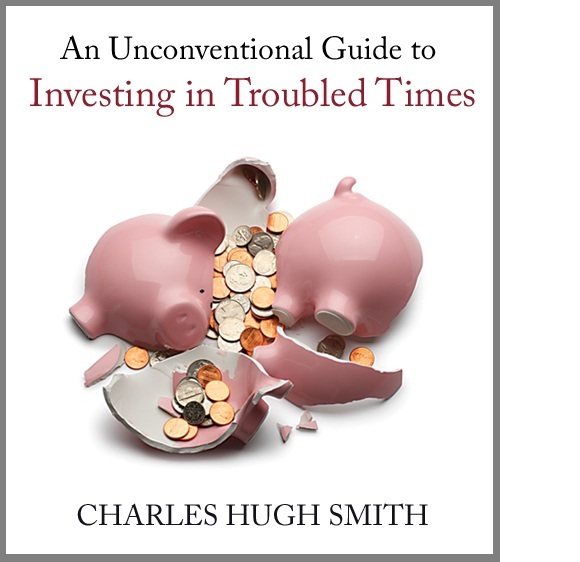As the Debt Machine Grinds to a Halt, Job Creation Falls Off a Cliff
What happens to a debt-dependent economy when it hits the wall of debt saturation? The job market and the very nature of work will change.
What is the future of work in a debt-dependent economy that no longer responds to more debt? In a word: bleak.
Given the "recovery’s" stagnant job market and the economy’s slide toward renewed contraction, it’s a timely question. To answer it, we must first ask, What is the future of the U.S. economy?
In broad brush, the Powers That Be have gone "all in" on a bet that this recession is no different than past post-war recessions. All we need to do to get through this “rough patch” is borrow and spend money at the Federal level, and the household and business sectors will soon recover their desire and ability to borrow more and spend it all on one thing or another. We don’t really care what or how, because all spending adds up into gross domestic product (GDP).
In other words, we're going to “grow our way” out of stagnation and over-indebtedness, just as we’ve done for the past fifty years.
Unfortunately, this diagnosis is flat-out wrong. This is not just another post-war recession, and so the treatment—lowering interest rates to zero and flooding the economy with borrowed money and liquidity—isn’t working. In fact, it’s making the patient sicker by the day.
The best way to eliminate the signal noise of official propaganda (“The stock market is rising, so everything’s great for everyone!” etc.) and the high keening wails of Keynesian cargo cultists is to construct a model of the underlying fundamental forces that will shape the future.
The best way to do that is to glance at a few key charts.
Let’s start with debt. Clearly, the “growth” of the U.S. economy since 1980 is debt-based. Debt has exceeded growth by 136%. If debt had risen in tandem with GDP, then total debt would be a mere $22 trillion instead of $52 trillion.

The next chart reflects how every incremental increase in debt has had a diminishing effect on growth. Where $1 of debt once added 70 cents to GDP, now it adds basically nothing, or even reduces GDP.

We hear a lot of euphoric babble about households "deleveraging;" that is, paying down debt and thus setting the stage for the next ramp-up of household debt. But the reality is not quite so euphoric. Compared to the explosion in household debt since 1980, which we might term the debt elephant, the recent “deleveraging” reduction in debt is more like a mosquito.

Next, let’s look at jobs and employment. To make sure we’re getting the full picture, let’s look at several measures of employment as a reflection of the underlying economy.
This first chart looks like a steady onward-and-upward trend of job growth. The “jobless recovery” appears to be a modest bump in the road of ever-rising employment.

By other measures, however, employment hasn’t hit a bump in the road; it’s off the road and sinking into a bottomless bog. Here is the civilian participation rate, which measures how many folks in the civilian population are participating in the labor market in one way or another.

By this measure, the labor market has retraced to the level of the 1981-82 recession thirty years ago.
Next, let’s look at another, perhaps even more telling metric: private payrolls per capita, which is basically a measure of how many jobs there are per capita in the economy.

What this means is that beneath the glitter of a “rising GDP” and “rising stock market,” the economy is producing far fewer jobs per capita.
If we look at the total number of civilians and the total number of jobs, the chart looks even uglier. We are back to the levels of 1970s stagflation, just as women began entering the workforce en masse to compensate for declining household purchasing power.

This next chart is civilian employment per capita, which is similar to the previous chart of private payrolls per capita, but includes all jobs, including public-sector/government employment. Once again it shows that the economy is back to the levels of the mid-1980s, even including the rapid expansion of local and state government payrolls.

Another way to measure the real performance of an economy is capacity utilization -- how much of the potential capacity of the economy is being used. In good times, capacity is added because the existing capacity is running full-tilt. In recessions, there is not enough demand to use the economy’s full capacity, and therefore no reason to add to capacity with business investment.
I’ve drawn some lines to clarify what happened during each primary phase of the post-war era. During the stagflationary 1970s, capacity utilization see-sawed between growth and recession, tracing out a series of lower lows and lower highs. This downtrend reflected the reality that the economy wasn’t growing; it was stagnating, hitting new lows with every downturn, and never reaching its previous high-point during recovery.
After finally hitting bottom in the 1981-92 recession when Federal Reserve Chairman Paul Volcker vanquished inflation by jacking up interest rates to 18%, the economy entered a 30-year cycle of financialization (deregulation of the banking sector and the rise of debt as the engine of growth), globalization, and technological innovation that fueled a multi-decade trend of rising productivity.
The wheels fell off the financialization and dot-com boom in 2000, and the Federal Reserve and federal government created an even more extreme version of financialization that inflated a gigantic debt/real estate bubble. Like all financial bubbles, this one burst, and once again the Fed and federal government scrambled to inflate another debt bubble.
Since the household sector was tapped out and its primary asset, the family home, had lost a third of its bubble value, the Federal government borrowed $6 trillion to bail out the banking sector and spread trillions of dollars around as stimulus and giveaways like "Cash for Clunkers."

Unsurprisingly, this injection of trillions of dollars did boost capacity utilization. Roughly 11% of the entire GDP is borrowed and spent every year now by the federal government. But just as in the stagflationary 1970s, the decline reached a new low and the subsequent rise never got close to the previous bubble high of 2006.
Now that the economy is rolling over again, capacity utilization is also declining.
None of this reflects a healthy economy. What it does reflect is an economy that has depended on ever-greater amounts of debt to power a diminishing trend of growth, and an economy which creates fewer and fewer jobs with ever-greater mountains of debt.
This is not a bump in the road; it is the exhaustion of the entire model of growth that we have depended on for the past 30 years. Once the debt saturation point has been reached, adding more debt subtracts from the economy rather than adds to it. This is reflected in the decline of employment by every metric: total number of jobs, civilian participation, payrolls per capita, and employment as a percentage of the total population.
We are past the point of debt saturation, and so we need a new model of employment, and indeed of “growth” itself. Sadly, as discussed in a recent report, the Status Quo financial witch-doctors have only prescribed more debt and more unproductive friction.
Unfortunately, as the above charts abundantly illustrate, the patient (the U.S. economy) hasn’t been cured; rather, its condition has gotten worse. The stock market is like a sort of makeup that has been slathered on by the Fed to give the appearance of health, but the internal measures of jobs and income (both declining) show that both the “health” and the “recovery” are illusory.
So, the key question to ask ourselves is, Where will the demand for work be in a post-debt, post-"cheap oil" economy"?
In Part II: The Future of Work, we tackle this critical question and provide a framework for potential job seekers/switchers to use in positioning themselves for meaningful and dependable employment in this coming era.
Click here to read Part II of this report (free executive summary; paid enrollment required to access).

If this recession strikes you as different from previous downturns, you might be interested in my new book An Unconventional Guide to Investing in Troubled Times (print edition) or Kindle ebook format. You can read the ebook on any computer, smart phone, iPad, etc.Click here for links to Kindle apps and Chapter One. The solution in one word: Localism.
My Big Island Girl(song) Thrill the players to bits by buying the tune from CDBaby or amazon.com (99-cent MP3 download)
Four new electric instrumentals by Coconut Charlie, CHS's longtime friend and musical mentor--give 'em a listen:
Crash Course Secret Asian Man Third Stone Tonic Float
Readers forum: DailyJava.net.
Order Survival+: Structuring Prosperity for Yourself and the Nation (free bits) (Kindle) orSurvival+ The Primer (Kindle) or Weblogs & New Media: Marketing in Crisis (free bits)(Kindle) or from your local bookseller.
Of Two Minds Kindle edition: Of Two Minds blog-Kindle
| Thank you, Toby B. (50 Qatar Riyals), for your profoundly generous contribution of books and riyals to this site-- I am greatly honored by your support and readership. |




























